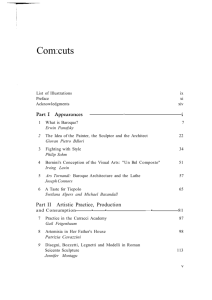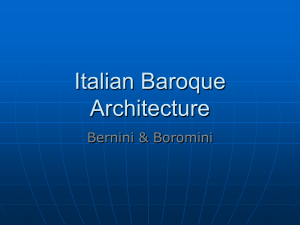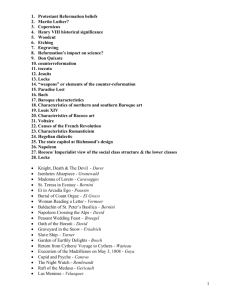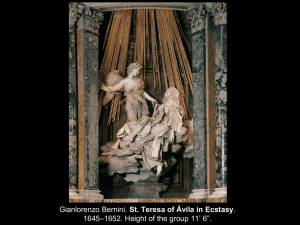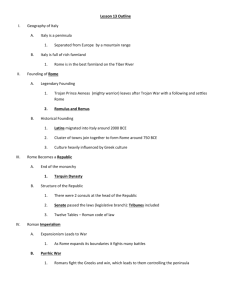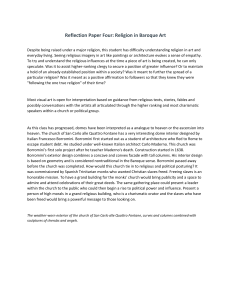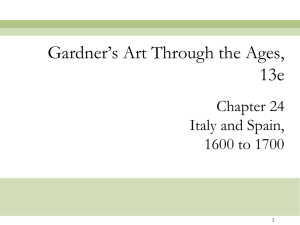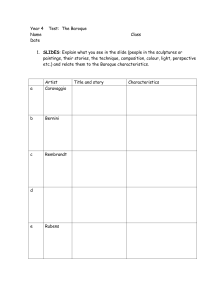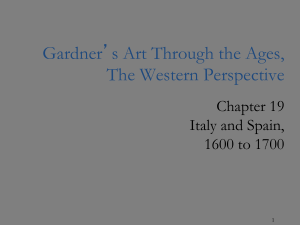AP Art History 18
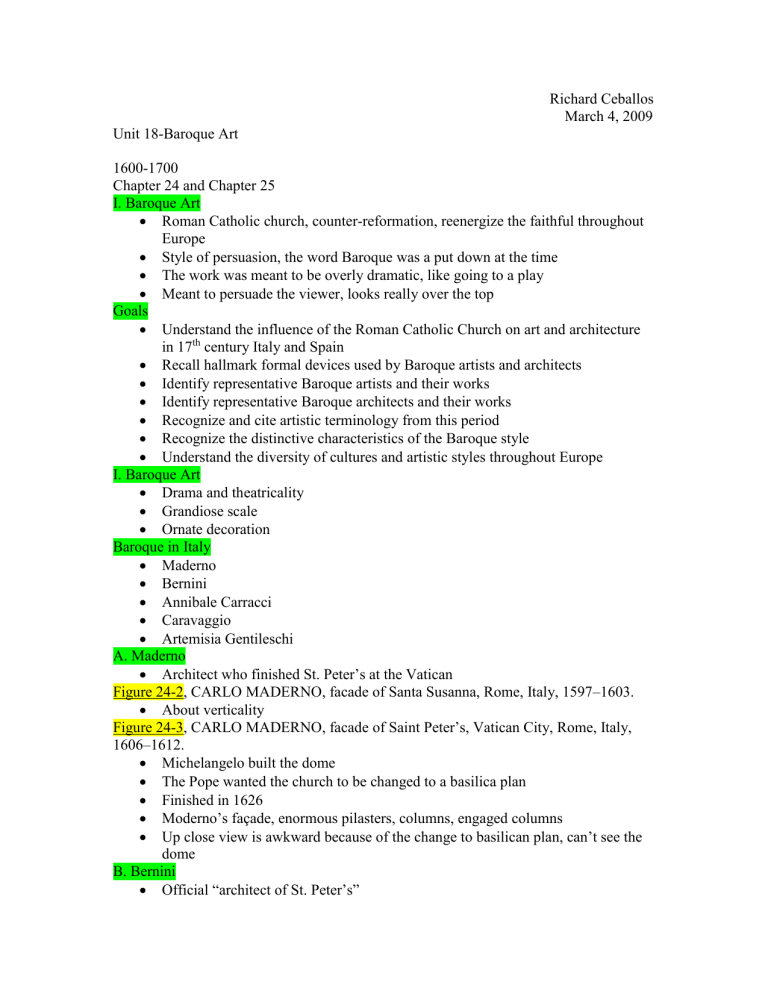
Unit 18-Baroque Art
Richard Ceballos
March 4, 2009
1600-1700
Chapter 24 and Chapter 25
I. Baroque Art
Roman Catholic church, counter-reformation, reenergize the faithful throughout
Europe
Style of persuasion, the word Baroque was a put down at the time
The work was meant to be overly dramatic, like going to a play
Meant to persuade the viewer, looks really over the top
Goals
Understand the influence of the Roman Catholic Church on art and architecture in 17 th
century Italy and Spain
Recall hallmark formal devices used by Baroque artists and architects
Identify representative Baroque artists and their works
Identify representative Baroque architects and their works
Recognize and cite artistic terminology from this period
Recognize the distinctive characteristics of the Baroque style
Understand the diversity of cultures and artistic styles throughout Europe
I. Baroque Art
Drama and theatricality
Grandiose scale
Ornate decoration
Baroque in Italy
Maderno
Bernini
Annibale Carracci
Caravaggio
Artemisia Gentileschi
A. Maderno
Architect who finished St. Peter’s at the Vatican
Figure 24-2, CARLO MADERNO, facade of Santa Susanna, Rome, Italy, 1597–1603.
About verticality
Figure 24-3, CARLO MADERNO, facade of Saint Peter’s, Vatican City, Rome, Italy,
1606–1612.
Michelangelo built the dome
The Pope wanted the church to be changed to a basilica plan
Finished in 1626
Moderno’s façade, enormous pilasters, columns, engaged columns
Up close view is awkward because of the change to basilican plan, can’t see the dome
B. Bernini
Official “architect of St. Peter’s”
Worked as an assistant to Moderno
Building large projects in Saint Peter’s
Figure 24-4, Aerial view of Saint Peter’s, Vatican City, Rome, Italy. Piazza designed by
GIANLORENZO BERNINI, 1656-1667.
Double colonnade, over life-sized statues of over 90 saints, (white marble)
People gather at the place to receive the Pope’s blessing
Colonnades, the church’s arms embracing and welcoming the audience
Figure 24-5, GIANLORENZO BERNINI, baldacchino, Saint Peter’s, Vatican City,
Rome, Italy, 1624– 1633.
Needed a dramatic focal point, dramatic canopy
Directly under the dome, over the spot where Saint Peter was buried
Creates an overwhelming monument
Took bronze from the Pantheon, save money? Political statement?
Four enormous angels, globe with a cross on top
Ornately decorated, columns with little bees on it, Pope (Pope’s family symbol was the bee), Pope wanted his family’s symbol to be included
Figure 24-6, GIANLORENZO BERNINI, Scala Regia (Royal Stairway), Vatican City,
Rome, Italy, 1663–1666.
Optical illusion, light
Figure 24-7, GIANLORENZO BERNINI, David, 1623.
Another David, uniquely Baroque, he is in action
Refers to the first Baroque statue
Involves the viewer (almost like the giant is behind you)
Figure 24-1, GIANLORENZO BERNINI, interior of the Cornaro Chapel, Santa Maria della vittoria, Rome, Italy, 1645-1652.
The ecstasy of Saint Teresa
Painting, sculpture, and architecture all combined, creates a stage
Figure 24-8, GIANLORENZO BERNINI, Ecstasy of Saint Teresa, Cornaro Chapel,
Santa Maria della Vittoria, Rome, Italy, 1645–1652.
Fell into trances and had religious visions
Angel is stabbing her in the chest
The texture of the clouds, drapery, skin is carefully illustrated
The rays of light, hidden window that would allow for light to enter
Box seats, marble figures watching the scene (play)
C. Borromini
Undulating walls
Third architect
Bernino professional rival, wanted to more Baroque
Figure 24-9, FRANCESCO BORROMINI, facade of San Carlo alle Quattro Fontane,
Rome, Italy, 1665– 1676.
Undulating, convex and concave effects, looks like the columns are moving
Figure 24-10, FRANCESCO BORROMINI, plan of San Carlo alle Quattro Fontane,
Rome, Italy, 1638–1641.
The illusion of movement
Figure 24-11, FRANCESCO BORROMINI, San Carlo alle Quattro Fontane (view into dome), Rome, Italy, 1638-1641.
Cofferings, smaller as they move up, creates sense of movement
Dome and walls go together, made for the plan
Figure 24-12, FRANCESCO BORROMINI, Chapel of Saint Ivo, College of the
Sapienza, Rome, Italy, begun 1642.
Concave and convex working against each other
Figure 24-13, FRANCESCO BORROMINI, Chapel of Saint Ivo (view into dome),
College of the Sapienza, Rome, Italy, begun 1642.
Pretty insane dome
